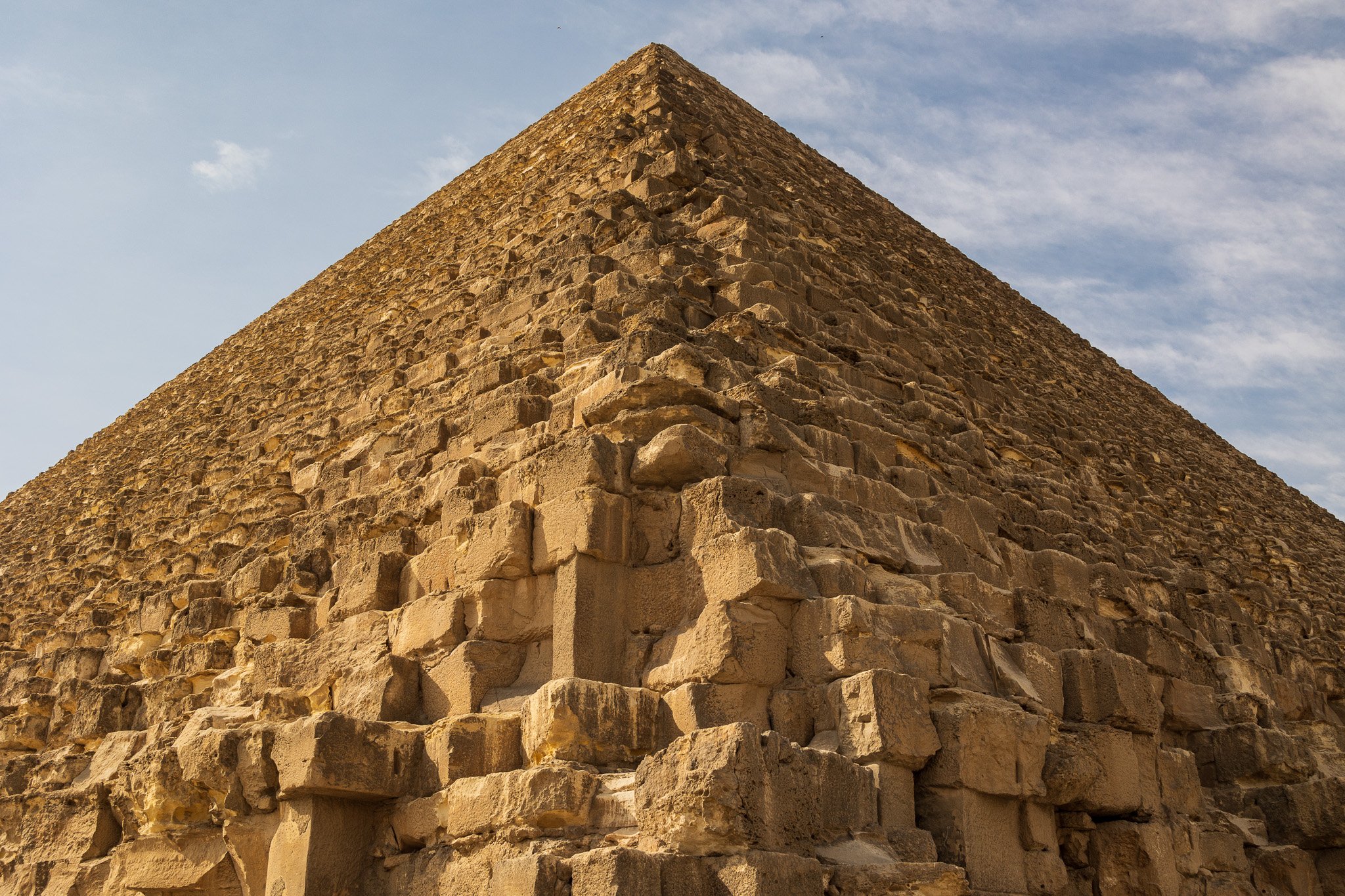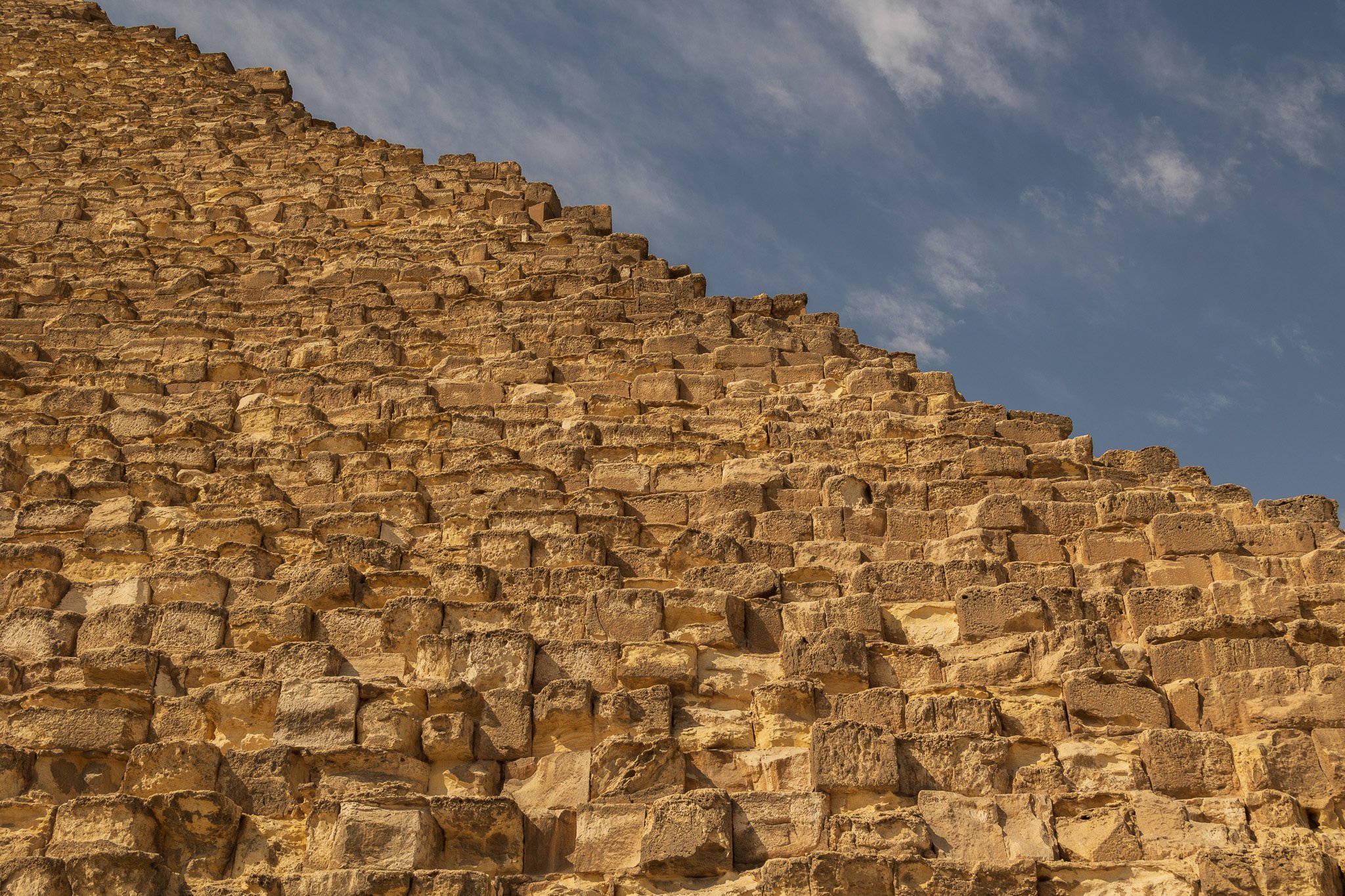In Karl’s letter to the Montreal Star on April 14, 1901, he writes: “Continuing the journey past the museums, for another seven miles on the tram car, one arrives at the foot of the range of hills on which are the Giza Pyramids, the Sphinx and old tombs. On alighting from the tram, the visitor (if he is a European and looks like a tourist) is immediately surrounded by a host of donkey and camel boys who offer to take him up the steep, winding road to the foot of the Pyramid for the small sum of 5 piastres (one shilling) or two if they can’t get five.
Soon we arrived at the base of the immense big stone erections 450 feet all the way from 18 to 40 inches in diameter and one cannot help feeling awed as he gazes at the towering heights above and wondering how such huge blocks could ever have been raised so far up in the air without any of the modern appliances of the present day. From a distance of five miles as I drew nearer the Pyramids they looked as though the sides were quite smooth but on a nearer view they are seen to have steps all the way to the top, as each layer of stone is placed a little ways back from the edge of the layer underneath so they look triangular in shape. A building at the foot of the largest four which at a distance looks like a small hut is found to be a large hotel which was built by the Khedive* at the time of the Prince of Wales’ visit to Egypt at a cost of £100,000.”
Built when Egypt was one of the world's richest and most powerful civilizations, the pyramids—especially the Great Pyramids of Giza—are some of the most magnificent structures of history. The pyramids are royal tombs built for three different pharaohs.
The largest and oldest pyramid of the group, called the Great Pyramid, was built for Khufu, known also as Cheops, the second king of the 4th dynasty. The two other major pyramids were built for Khufu's son, King Khafre (Chephren), and a successor of Khafre, Menkaure (Mycerinus). While these three pyramids are the most famous in Egypt, more than 130 other pyramids have been discovered scattered around the area of Ancient Egypt.
My visit to the great pyramids, 120 years after Karl's, shared more similarities than differences.
I arrived at the visitor centre by car rather than by tram, paying 240 Egyptian pounds (about 10 Canadian dollars) and undergoing security checks before access was granted.
Like Karl's experience, I found myself immediately surrounded by hawkers aggressively selling transport around the pyramids—donkeys, camels, or horse and cart. It was overwhelming, and the relentless sales pitches were disheartening, particularly witnessing the poor treatment of animals. Sadly, this initial encounter left a negative impression. The site's vastness meant that individuals with physical limitations often resorted to animal transport to access the pyramids.
Astonishingly, accessibility seemed overlooked for a UNESCO World Heritage site. On a personal note, dear reader, I envision replacing these animals with multi-passenger electric golf carts similar to those available in Agra at the Taj Mahal. But instead of dwelling on this unfortunate visitor experience, let me return to focusing on the pyramids.
Echoing Karl’s observations, standing at the base of the Great Pyramid, there’s an immediate appreciation for this immense structure of over two million stone blocks, each placed meticulously atop another, reaching 450 feet. Expressing its size is challenging, but being at the base feels like standing amidst two blocks high or two layers. In total, there are 216 layers! When Karl visited, the method of placing these stones remained a mystery, and to some extent, it still is today, even though it’s estimated around 100,000 people were involved in the construction.
Originally adorned with a layer of white limestone that reflected the sun, preserving the stones, the pyramids have weathered time, earthquakes, and sand storms. This casing remains visible only on the Great Pyramid. I appreciated Karl’s perspective, expecting the pyramids to appear smooth from a distance, only to discover their stepped nature up close.
The pyramids were amazing; it’s surreal and astounding that this ancient wonder was constructed and remarkable that it still exists. I’m glad Karl brought me here, but sadly for me, dear reader, the overall experience as a visitor left a lot to be desired.
Despite the disappointments, there's hope for positive changes. Since 2015, non-invasive technologies like infrared and 3D scanning have unravelled more mysteries about these ancient wonders. Notably, a concealed corridor measuring nine meters (30 feet), was discovered a month after my 2023 visit near the main entrance of the Great Pyramid. Many more revelations likely await discovery, and I remain hopeful that, parallel to the anticipated Grand Egyptian Museum and its commitment to enhanced visitor experiences, the Great Pyramids will undergo improvements in the next overhaul.
*This small hut –– well, small compared to the pyramids –– was built back in 1869 as a hunting lodge and opened as a hotel in 1886, with the Prince of Wales (Edward VII) being one of the first guests.
If you are new to the Karl Chronicles, get caught up on our expedition around the world! Start here 150 highlights from 150 Chronicles
Then get caught up on the rest of our journey, click here for more Karl Chronicles
The Karl Journey is now registered as an official expedition with the Royal Geographical Society
















